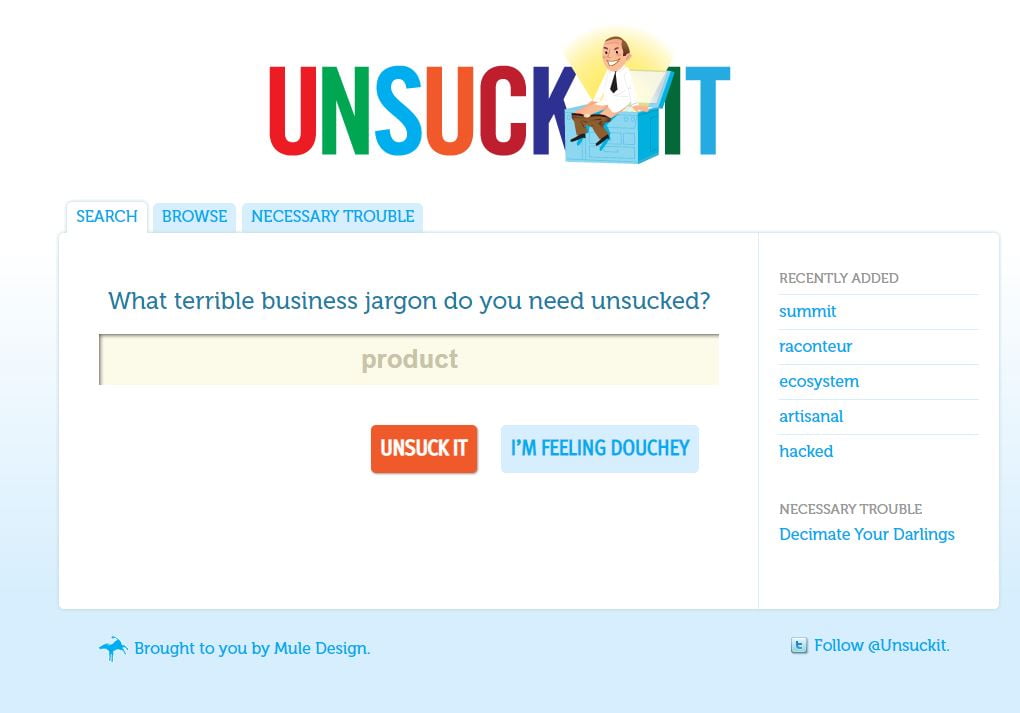You need to work smarter, not harder.
Why pour blood, sweat, and tears into a copywriting project when you spend much less effort and get the same job done?
That’s where copywriting tools come into the picture.
They’re like tools on Inspector Gadget’s belt. (I hope you watched that cartoon to understand.)
And, copywriters wear enough hats to fill up a Nike store…
Writing, editing, SEO, proofreading, prospecting, marketing, advertising, and the list goes on.
So, naturally, you need a good tool stack.
The ones I’m sharing with you today will save you time, energy, and level up the quality of your writing.
Take a look. 👀
1. Grammarly
You knew this was going to be on the list.
Grammarly is a free grammar tool that ensures there’s no cringe-worthy errors in your writing.
You can sign up for the web app version here or download the Google Chrome extension.
The extension integrates with most major platforms, including other tools I’ll be mentioning, but you can never go wrong with the web app.

Click the “New” button on the dashboard and paste in any copy on the next page.

Grammarly will offer suggestions for improving delivery, engagement, clarity, spelling, and more.
Hover over any highlighted text on the left and you will be able to accept or decline changes.
Take note of what it suggests because you can avoid it next time to continually refine your writing skills.
2. BuzzSumo
Do you write blog posts for clients?
Then you know that coming up with topic ideas is migraine-inducing.
It allows you to find the most popular content in any niche for content ideation and market research.
Begin by signing up for an account and typing in a search term on the “Topics” page.

BuzzSumo will find all of the most viral content related to the topic you entered and related sub-topics.
Use this as a way to come up with new ideas and understand what a particular audience engages with.
3. Hemingway App
Who says you have to use only one grammar editing tool?
In fact, the more the merrier!
Or, perhaps Grammarly and other tools aren’t for you.
That’s okay.
Because there’s Hemingway App.
This free web app will grade the reading level of your writing and provide suggestions for fixing things like passive voice.

Simply paste in any material and its artificial intelligence will highlight anything it believes it worth investigating.
Every color has a different meaning, too:
- Blue: adverb goal.
- Green: passive voice.
- Purple: simple alternative available.
- Yellow: Hard to read the sentence.
- Red: Very hard to read the sentence.
It’s lightweight, free, and easy to use. Feel free to mix into your copywriting process when you want a change of pace.
4. Google Drive
Copywriting requires expert organization.
After all, you have content guidelines, reports, data, ideas, and more to coordinate while writing.
That’s a lot.
It can be stressful juggling all of those things, too, right?
It doesn’t have to be.
I recommend using Google Drive to store all of your copywriting material.
This includes deliverables, resources, invoices, and other documents.
Begin by right-clicking under the “Folders” area and creating a new folder. I like to create folders for each client, project, etc.

Open the folder and select the “New” button from the left sidebar.
You can add documents, spreadsheets, presentations, or whatever else you need.
5. HubSpot
Prospecting, nurturing relationships, and generating new writing leads are a few of the daily tasks of a copywriter.
While you could live in the stone age and do it all through spreadsheets (admittedly, I like to sometimes), a CRM will be one of the best investments you make.
It fascinates me that marketers—whether they’re writers or not—don’t use customer relationship management software.
It takes all of your leads, clients, prospects, and places them in one single location.
No more jumping around Google Chrome tabs or several tools!
Sign up for a free account here.

Next, add contacts by clicking the “Contacts” tab and “Create contact” button.

You can send individual emails to contacts by visiting their profile and clicking the “Email” option.
Additionally, add notes, change their lead status, and schedule meetings directly through HubSpot.
6. WordCounter
Many projects require a certain word count.
This is especially the case for blog posts, editorials, etc.
So, naturally, you keep a hawks eye on the word count, right?
I know I do.
While I hope you don’t manually count each word, there are tools to instantly do it for you.
One of which is WordCounter.
This free tool automatically calculates the number of words and characters of any text.

I like to use this for calculating word count for my personal projects, but also snooping on competitors.
How many words did they write for a blog post? How about that winning sales page?
You get my point.
7. Ubersuggest
Websites, articles, and many pieces of copy require search terms.
These help the material be found easier through search engines, which also results in traffic and sales.
Keyword research is the most important step in on-page SEO for this reason.
If you’re writing SEO content, try using the free tool Ubersuggest from Neil Patel.
This tools gives you keyword data, suggestions, content ideas, and more.
Begin by entering a keyword on the homepage and clicking “Search.”

This will take you to the following page where you will have mountains of search data to play with:

You can download the results as a CSV file or copy it directly to clipboard if you wish to paste it into a spreadsheet, for example.
8. SEMrush
While keyword research is one planet in the entire galaxy of SEO, there are many other things to be aware of.
Tracking them all can be a real pain, too.
SEMrush makes it a breeze. though.
This free SEO suite offers keyword rank tracking, backlink profiles, traffic history, and more.
I like to use it to guage how I or my clients are performing in the SERPs which is also a reflection of content and SEO efforts.

Use SEMrush to:
- Analyze keyword rankings and if content is performing as intended.
- Improve your backlink profile and find new opportunities.
- Determine how steadily and fast organic traffic is growing.
- Find new keyword and content ideas.
- Break down the competitor’s organic and paid search strategies.
9. Yoast SEO plugin
Do you use WordPress?
Heck, 30% of all websites on the internet are powered by it.
If you do, don’t miss out on free SEO juice by installing the Yoast plugin.
This will make optimizing content you write for search engines easy as pie.
In particular, I find the title tag, URL, and meta description editor very handy.
It allows me to directly edit metadata—which plays a role in rankings—in a matter of seconds.

Additionally, it gives you a readability and SEO score to ensure that your writing remains on track to achieve goals.
There’s also features for submitting XML sitemaps, de-indexing certain content, and more useful gizmos.
10. Read-able
Readable is a free readability tester from WebFX.
Because, after all, it’s good if customers can read your copy. 😉 Otherwise it will do nothing!
Even if you think you’re the Tiger Woods of writing, it’s always good to use a tool to find small tweaks and errors.
Begin by entering a URL or directly pasting in text.

Click the “Calculate Readability” button and it will display a list of metics about the content.

They include:
- Reading level
- Reading ease
- Fog score
- Number of sentences
- Numbers of words
- Etc.
Use this to determine if copy is easy to read and matches the reading level customers are at.
11. CoSchedule’s headline analyzer
What’s one of the most important parts of copy?
No, it’s not the sale. Although, that’s very important.
This is what draws the reader in to read the rest of the material.
It’s like a shiny car at a dealership. You see the Ferrari outside and it gets you walking in to see more.
But, what makes a good headline?
Many things. Emotion. Uniqueness. Mystery. The list goes on.
CoSchedule’s headline analyzer comes in handy for finding titles that are winners.
Type in a headline idea to begin.

Click “Analyze Now” and the tool will grade the headline.

I suggest for aiming above a score of 70.
Use uncommon, emotional, and powerful words to boost your score.
12. Thesaurus.com
Do you ever find yourself using the same words over and over again?
Me, too.
I keep it open in a new tab while writing and it’s a lifesaver.
Any time I feel like I keep re-using a word, I type it into Thesaurus and it gives me new ideas.

Not only does this improve my vocabulary and spices things up, it keeps readers engaged because copy doesn’t feel repititive.
13. Unsplash
Copy and images go hand-in-hand.
But, where can you find high quality images to use?
They are a commerical free photo website meaning that you don’t have to pay for the photos.

Enter a keyword on the homepage and click the search button.
This will net all of the related photos for you to use.

Click any image and save it or download a specific resolution.
Navigate through the different tags it suggests to find similar photos and I also recommend keeping note of photographers you like.
They will continue to upload more great images to use in your future copywriting projects.
14. Unsuck It
Similar to when you use too much of the same word, sometimes it’s a single word that causes the most problems.
Do you know what I mean?
Technical jargon.
It can be the bane of a copywriter’s existence.
A few jargon later and customers are confused about a topic or product.
This is precisely why you need to use Unsuck It to remove the suck out of your writing.
Enter a complex word on the homepage and click “Unsuck It.”

Browse through the list of words it presents and swap it out so readers don’t feel like they’re reading a Ph.D. paper.

15. Hotjar
Let’s say you have a landing page. Or a sales page. Or anything for that matter.
Wouldn’t it be amazing if you know where users are clicking and engaging to optimize the copy and design?
It’s possible with something a heatmap.
Think of it as thermal vision for your website.
You connect an asset, it analyzes how users engage, and leaves heat spots for you to interpret. It looks like this:

Perhaps users are paying attention to features and testimonials the most, but you’ve emphasized pricing. Reverse that and conversions could skyrocket!
If that sounds exciting, try out Hotjar. It’s a free heatmap tool you can begin using today.
Wrapping up the best copywriting tools
Copywriting involves a billion processes.
Okay, maybe not that much. But you get my point.
You can make everything easier on yourself while producing better copy by using the copywritng tools I covered today.
What’s your favorite one?














